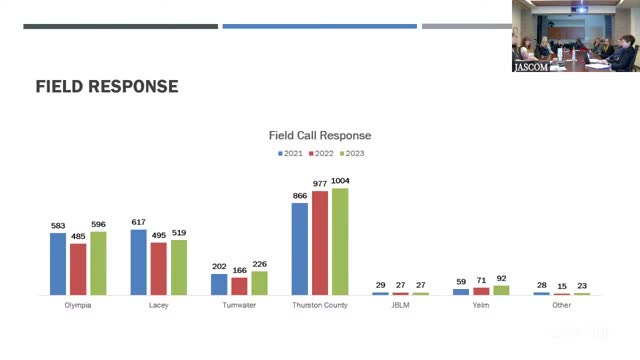Animal cruelty cases surge as field service calls rise
October 14, 2024 | Lacey, Thurston County, Washington
This article was created by AI summarizing key points discussed. AI makes mistakes, so for full details and context, please refer to the video of the full meeting. Please report any errors so we can fix them. Report an error »

In a recent government meeting, officials reported a significant increase in field service calls related to animal control, with a year-to-date rise of over 20% compared to the previous year. This surge is attributed to a series of large-scale animal intake cases, including a notable hoarding incident involving 157 calves and a cockfighting case with 64 chickens. These cases have not only increased the workload for animal control but also highlighted the challenges of managing such incidents in unincorporated areas of Thurston County, where property size allows for more concealed operations.
The agency has been proactive in adapting to new legislation, being the first to implement House Bill 1234 regarding animal seizures and bond payments shortly after it was enacted. However, the costs associated with these operations have raised concerns, as they often exceed the budget allocated for emergency veterinary services. The agency is currently absorbing these expenses without passing them onto local jurisdictions, which complicates financial planning.
Additionally, the meeting addressed the gradual recovery of pet licensing sales, which had seen a decline during the COVID-19 pandemic. In 2023, there was a reported increase of 3.58% in licensing compared to 2022, signaling a positive trend as the community adjusts to post-pandemic norms. Officials emphasized the importance of promoting pet licensing as a means to reduce jurisdictional assessments, urging a collaborative effort among local governments to enhance awareness and participation.
The discussion also touched on the impact of recent high-profile animal cruelty cases, which have led to an influx of donations from both local and international supporters. The agency has received contributions from various foundations and individual donors, significantly boosting their financial reserves.
As the agency continues to monitor service gaps and the effectiveness of new initiatives, officials expressed optimism about the potential for increased community engagement and support in the coming years. The focus remains on ensuring the welfare of animals while managing the operational demands placed on animal control services.
The agency has been proactive in adapting to new legislation, being the first to implement House Bill 1234 regarding animal seizures and bond payments shortly after it was enacted. However, the costs associated with these operations have raised concerns, as they often exceed the budget allocated for emergency veterinary services. The agency is currently absorbing these expenses without passing them onto local jurisdictions, which complicates financial planning.
Additionally, the meeting addressed the gradual recovery of pet licensing sales, which had seen a decline during the COVID-19 pandemic. In 2023, there was a reported increase of 3.58% in licensing compared to 2022, signaling a positive trend as the community adjusts to post-pandemic norms. Officials emphasized the importance of promoting pet licensing as a means to reduce jurisdictional assessments, urging a collaborative effort among local governments to enhance awareness and participation.
The discussion also touched on the impact of recent high-profile animal cruelty cases, which have led to an influx of donations from both local and international supporters. The agency has received contributions from various foundations and individual donors, significantly boosting their financial reserves.
As the agency continues to monitor service gaps and the effectiveness of new initiatives, officials expressed optimism about the potential for increased community engagement and support in the coming years. The focus remains on ensuring the welfare of animals while managing the operational demands placed on animal control services.
View full meeting
This article is based on a recent meeting—watch the full video and explore the complete transcript for deeper insights into the discussion.
View full meeting
